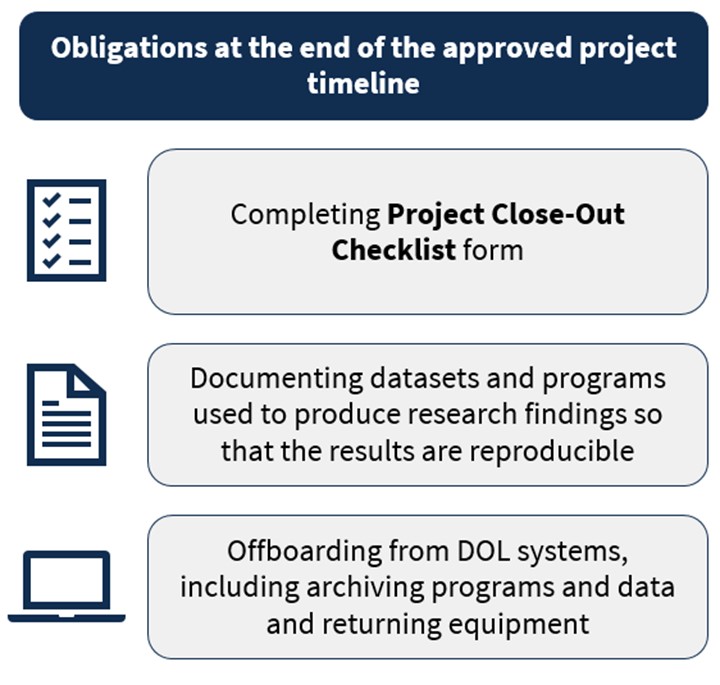This page discusses practices for approved researchers completing a Secure Transfer, Restricted-Use Data Lake (STRUDL) project.
Each section has an accompanying video and text is provided as a visual aid. Documents referenced in each video are always formatted in bold and descriptions of each document can be found on STRUDL: Forms. We encourage potential applicants and program participants to reference the STRUDL Handbook for more detail on the full program process.
In Video 4.1, we will discuss key timelines and processes that must be completed before a project’s close-out date: documenting research output, requesting access for follow-up work and revise and resubmit (R&R) requests, and returning physical DOL equipment and materials.
Video 4.1 – Secure Transfer, Restricted-Use Data Lake Close-Out: Research, Project, and Equipment Practices
Overview
In this section, program participants will learn about the following:
- Important deadlines and required processes during project close-out
- Required materials to provide to the U.S. Department of Labor (DOL) before project close-out
- Follow-up work and R&Rs
- Returning DOL equipment and physical materials
What are the key deadlines and requirements approved researchers should know ahead of the project close-out date?
To allow for an iterative review, approved researchers must start the disclosure review process at least 90 days before expecting released results from DOL. This policy applies regardless of external deadlines, so approved researchers should plan accordingly.
Note that some agencies will require review of content for quality and accuracy in addition to disclosure. Approved researchers will be expected to collaborate with the STRUDL team and agency staff to determine timelines and requirements for this review, the specifics of which will vary by agency.
Requests for modifications to the project, including extensions of the project term, must be submitted at least 90 days in advance of the project close-out date.
Other obligations at the end of the approved project timeline include the following items, depicted in Figure 1:
- Completing the Project Close-Out Checklist form (a description of which can be found on STRUDL: Forms)
- Documenting datasets and programs used to produce research findings so that the results are reproducible
- Offboarding from DOL systems, including archiving programs and data and returning equipment

What materials do approved researchers need to submit with the Project Close-Out Checklist?
The Project Close-Out Checklist (a description of which can be found on STRUDL: Forms) is designed to document the benefits of access to DOL data. Broadly, the checklist asks approved researchers to
- provide any promised benefits to DOL,
- summarize the key research findings,
- compare the accomplished research benefits to the research proposed in the application process, and
- document any changes made over the course of the project.
Approved researchers must also list key deliverables and communications from their access to the data and verify that these outputs underwent disclosure review. Detailed instructions for completing this form can be found in the STRUDL Handbook.
Research results must be made publicly available on the DOL website per the terms of STRUDL; the project close-out checklist will also facilitate this.
What if approved researchers need additional access to address a R&R request or conduct follow-up work after the project term has expired?
Ideally, R&R requests should be accommodated within the approved project timeline. If necessary, approved researchers may submit up to two requests for readmission after the project term expires. These requests must be made only for reasonable and relevant amounts of work, and all outputs must go through the disclosure review process. See the STRUDL Handbook for more details on this process.
Approved researchers interested in carrying out follow-up work that is not covered by an R&R request after the project term ends must submit a new proposal under the standard review process, covered in detail in the STRUDL Handbook.
How should approved researchers document their work to ensure the results are reproducible?
Computational reproducibility is a minimum standard for quantitative social sciences. Adopting the best practices of reproducible research like clear documentation and using code for all steps in analysis will
- improve research,
- speed up the disclosure review process, and
- ensure that the STRUDL team can support projects after researchers return their DOL equipment and no longer have access to the confidential data.
Documentation of
- datasets (including intermediary output) via meaningful file and variable names,
- programs and program logs,
- scripts (if applicable), and
- any other element or method required to recreate the project results
should be ongoing throughout the project to ensure that the research results can be reproduced by other researchers or DOL staff. Approved researchers will be asked to provide these materials upon project completion.
What is the process for returning physical DOL materials, like computers and PIV cards?
Note: Approved researchers in STRUDL should also plan to archive programs and data on DOL systems before returning their equipment. Approved researchers will receive more information about how to do this once they gain access to DOL systems.
Approved researchers must return physical equipment provided by DOL when
- the researchers no longer need access to STRUDL data (i.e., they are transitioning off the project, they have changed jobs, etc.), OR
- the project is past its close-out date.
Once the project dissemination materials have been approved, DOL staff will initiate the laptop return process, and users will receive more detailed instructions at that point. If the overall project is ongoing, but an approved researcher still needs to return their laptop, they should email STRUDL@dol.gov to initiate the equipment return process.
